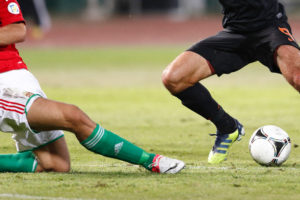
Why football moves do not exist
We do not have a body plus something else. In a previous blog it was shown that the word ‘mental’ does not exist. Human beings do not exist of ‘a body plus something else’. There is no something else. There is only a body and this body is already complex enough. Obviously, this body has body parts and one of these body parts is our brain. In our brain many complex processes take place which we only start to understand gradually. But what we do know is that our body interacts with the surrounding.
The difference between an action and a movement
Let’s say we take a bottle off the table with our hand. This interaction between our body (hand) and the surrounding (bottle) is what we call ‘lifting’. Now just imagine that our body would do exactly the same except for the interaction with the bottle. Would you still call this an (inter)action? No, because you are not interacting with the surrounding. You are just moving your arm! This is the philosophical difference between an action and a movement. When the body is interacting with the surrounding it’s called an action. If the body is not interacting with the surrounding it’s called a movement. The logical consequence is that the term ‘football move’ or ‘football movement’ does not exist.
Football movement does not exist
Football is a sport of interactions. Players are interacting with the football surrounding: the ball, teammates, opponents, pitch, goals, etc. These interactions are what we call football (inter)actions like passing, pressing and creating space. In other words, the performance of players
Football actions are made of movements
The above philosophical analysis does not mean the word ‘movement’ does not exist at all in football. The only thing I have done so far is putting the term ‘movement’ in perspective and show that it does not exist in combination with the term ‘football’. But independently it does exist as football actions are made of a cluster of movements. For example, when passing the ball a player has to swing his leg, flex and extend his knee, etc. These are all movements as an integral part of
Top-down or bottom-up training?
In many sports the movements are the objective. For example, in gymnastics one has to perform certain movements in an ideal and stereotype way to get more points from the jury. In these sports, it’s important to train bottom-up. In other words, gymnasts develop their movements bottom-up from simple to complex. Step by step they improve the quality of movement. In sports like football the interaction with the surrounding is the objective and not the movements. Therefore, in football training the football (inter)actions should be the starting point. Football actions are trained top-down with players interacting with realistic football surroundings. These surroundings will only be top-down simplified if necessary. So, the choice between a top-down or bottom-up training approach is not a matter of opinion. It’s the logical consequence of the characteristics of the sport. It’s a fact. In gymnastics one is judged on how one moves the body. So, gymnasts have to train bottom-up from movement to action. On the other hand, in football it’s about how you interact with your surrounding. So, players have to train top-down from (inter)action to movement (if necessary).


